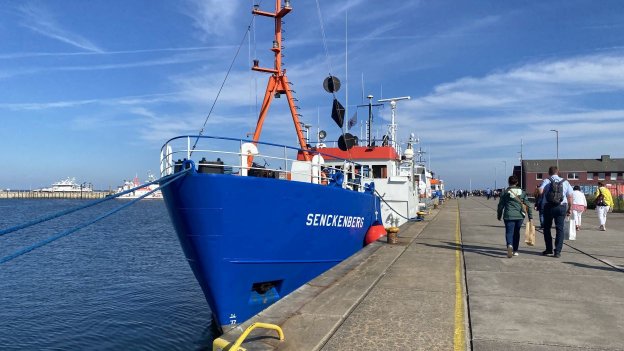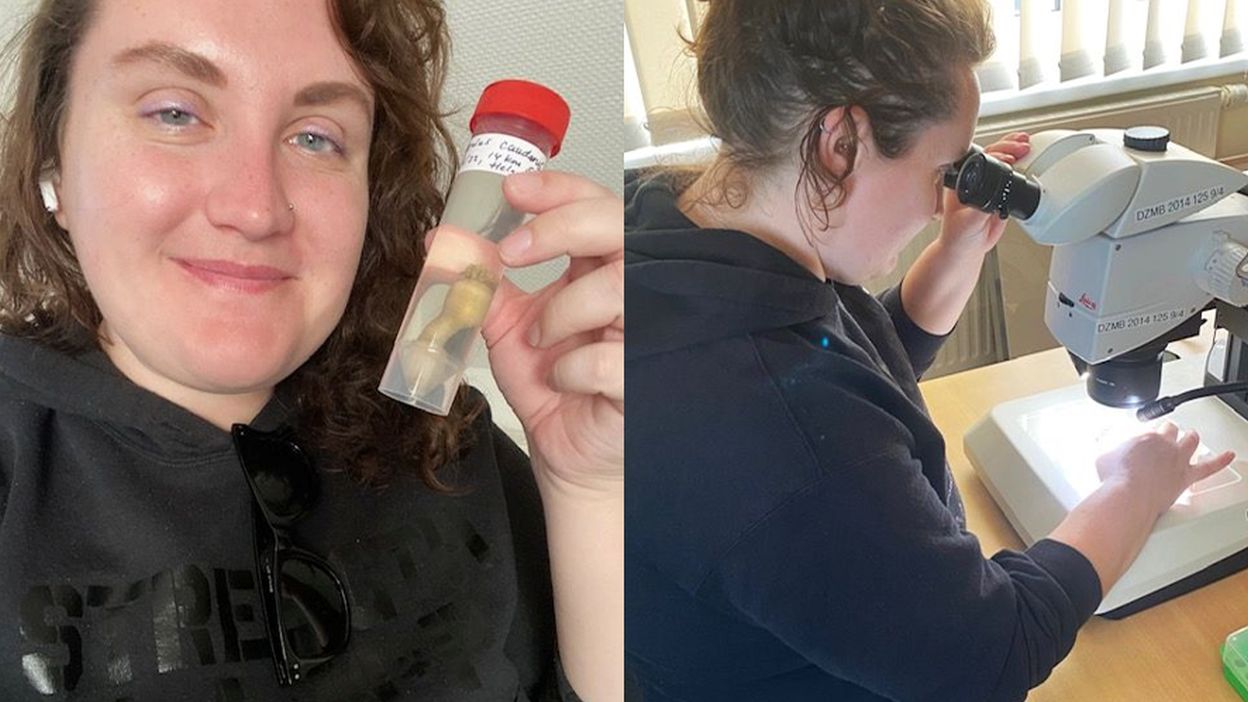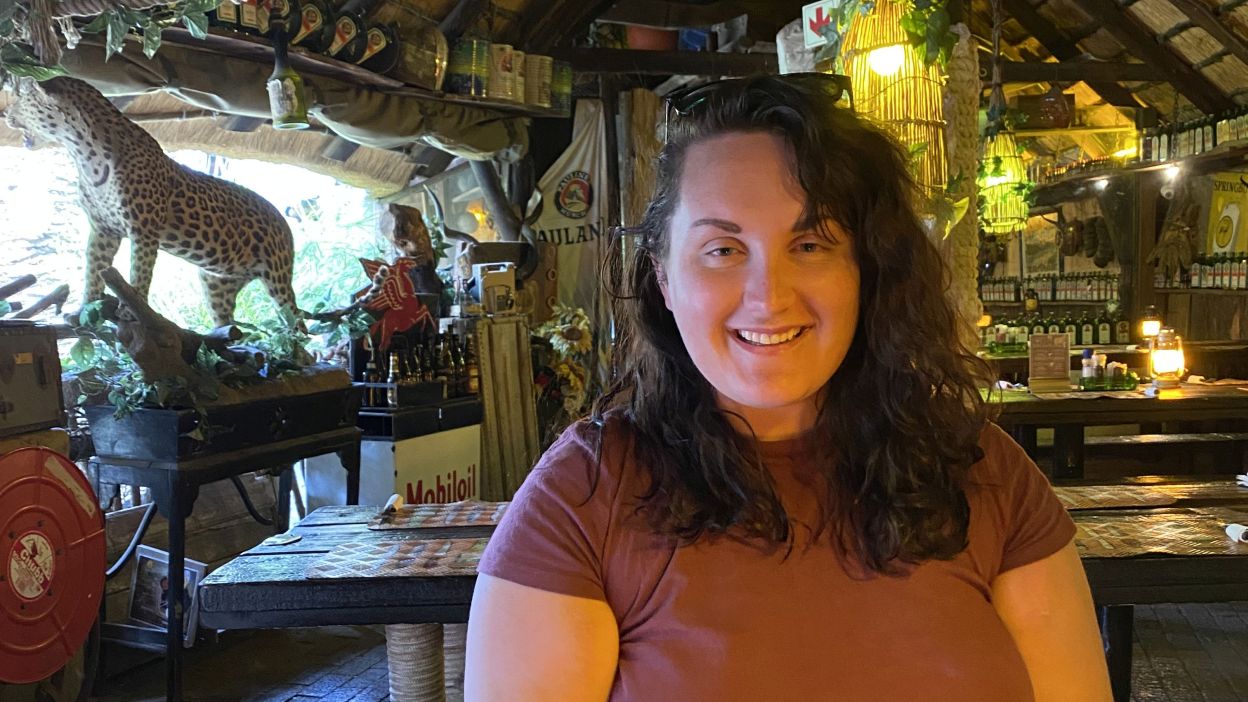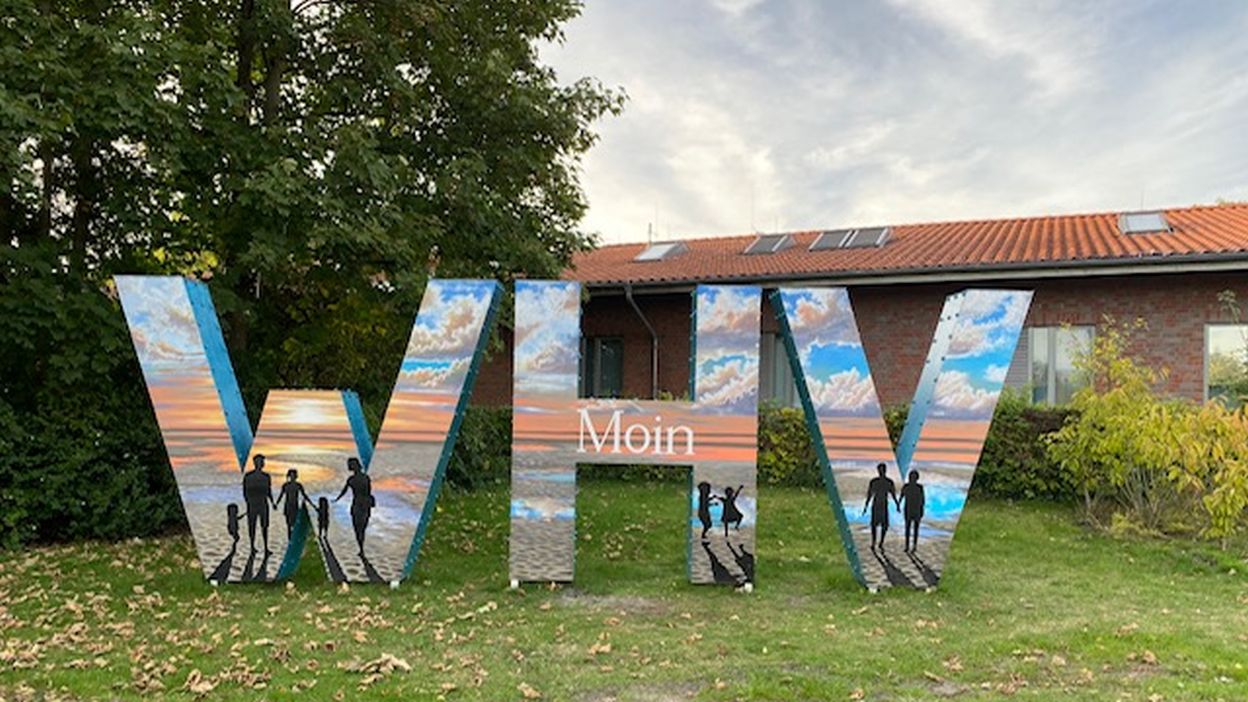Katherine Turk
 Privat
Privat
The research vessel FK Senckenberg, on which Katherine Turk spent four days collecting specimens and box cores
"It was the opportunity of a lifetime and truly an honor to receive the Respekt & Wertschätzung Scholarship from the DAAD-Stiftung, allowing me not only to foster transatlantic collaborations and friendships, but also to conduct my research in the best-suited place for it on Earth: the Wadden Sea."
Katherine Turk is a doctoral candidate in the field of Geoscience. Thanks to the Respekt & Wertschätzung Scholarship, awarded to her by the DAAD-Stiftung and established because of the funding by Dr. Michael Aven, she was able to make progress in her dissertation by conducting research at the Senckenberg am Meer research institute in Wilhelmshaven.
Here, she talks about her research and her experiences in the north of Germany:
My dissertation research focuses on the evolution of early complex behavior among some of the first animals – priapulid worms – during what is known as the Ediacaran-Cambrian transition (~550 - 539 million years ago). In particular, I am interested in how the burrowing of these pioneering animals might have facilitated early complex life’s descent from the sediment-water interface into the sediment column via particle reworking and the downward transfer of oxygen and other nutrients, thus potentially driving ecological change so impactful as to have kickstarted the subsequent 540-million-year trajectory of life on Earth. However, the relative age and paucity of easily-preserved hard parts such as shells, bones, and teeth (all of which had yet to evolve) from this interval makes it inherently difficult to study biological change from fossils alone. As such, it is necessary to turn our attention to the discipline of actuopalaeontology, which seeks to understand fossil record patterns from the perspective of modern organisms and sedimentological processes.
While priapulids were once the apex predators of the early- to mid-Cambrian, their role in modern marine ecosystems 500 million years later is diminished, and they form uncommon constituents of high-latitude seafloor ecosystems. One of the places they can still be found is in the North Sea, meaning Germany was the perfect choice for me to conduct my proposed research – not only for its proximity to these enigmatic organisms, but because it is the home of the Senckenberg am Meer (SaM) research institute in Wilhelmshaven. I established contact with Dr. Achim Wehrmann, head of SaM’s Division of Actuopalaeontology, with whom I developed a collaborative research proposal to examine the effects of priapulid burrowing in controlled environments. My initial application to the DAAD for a short-term doctoral research grant was awarded the Respekt & Wertschätzung Scholarship, donated by Dr. Michael Aven to support American students pursuing scientific research in Germany and thus allowing me to undertake this novel research over the summer of 2022.
The research process
As this project was among the first and most comprehensive of its kind from anywhere in the world, much of our initial time was spent sorting out logistics. The decision was made rather early on to rent a refrigerated shipping container for the experimental work, which would allow us to keep our specimens at temperatures similar to those in which they are found in the wild. This shipping container (later rather cheekily termed the “Center for Priapulid Excellence”) became the base of operations for the project. Inside, we set up four aquaria and layered mud with equally-thick regular and colored sand strata to observe eventual sediment reworking by the worms we were attempting to catch. GoPro cameras pointed at each tank would record time lapses of any bioturbation that occurred. A priapulid bycatch from researchers at the German Centre for Marine Biodiversity Research (DZMB) allowed us to test our initial tank setups; it was from this first attempt we discovered priapulids struggle to burrow in sandier surface layers, leading us to reset the tanks with thick mud layers interbedded with very thin colored sand layers. In late June, Dr. Wehrmann and I boarded the research vessel FK Senckenberg for a four-day cruise – or Forschungschifffahrt, a word I took great pleasure in using during my stay – for specimen collection. Armed with only a general idea of the areas in which priapulids had been previously collected, as well as bathymetric and sedimentological data, we were ultimately able to collect 40 specimens of Priapulus caudatus – a previously unheard-of number of priapulid worms. This in effect made the shipping container one of, if not the largest collection of captive living priapulids in the world.

Privat
Katherine Turk with the specimens collected during her research stay
Upon our return to land, we released groups of 8 to 10 priapulids into these stratified tanks, observing their effects on tank structure. At the same time, we took daily measurements of oxygen and pH levels in the water and at set sediment depths in both the bioturbation and control tanks. At the end of the experiments, we used metal piping to core sediments, which we cut into 1 cm-thick slices. These slices were then sieved to remove the mud content, allowing for examination of the bioturbation-induced redistribution of the colored sand layers throughout the tank. Finally, we have produced several time lapses and photo sets documenting the visual changes to tank structure over time.
Life in Germany
Senckenberg am Meer’s expertise in marine environments means there is always an international cohort of visiting scientists present. During my stay, I met and became friends with scientists not only from Germany, but also Russia, Mexico, the UK, Turkey, Iran, and India, as well as another scientist from the US. I was lucky enough to live in an attic room of the DZMB for the duration of my stay, which meant the other lodgers and I became fast friends, often sharing food we’d cooked or going out to drinks, the Christopher Street Day festivities, and the summer Stadtfest. The institute was also able to lend me a bike, which I made liberal use of for the entire summer. Coming from the US, where biking is largely uncommon due to cities designed around car infrastructure, as well as the dangers of sharing the road with unaccustomed drivers, this was a new experience for me! I grew to really love cycling around both Wilhelmshaven and the surrounding areas – something I’m going to miss in returning to America, as it’s (in my opinion) still too dangerous to do in Nashville, where I live. As Wilhelmshaven’s coastal location means it’s incredibly flat, I also picked up inline skating, which I quite enjoy (but can’t say I’m particularly good at quite yet).
I am someone who loves settling into a routine, and as I became more familiar with the city and my German improved, I began to partake in my own little rituals. Every Sunday, I would bike to the local cafe, where I would spend a few hours knitting, writing, or preparing for talks while partaking in coffee and varying types of cake while playing with the staff members’ dogs. On Wednesdays, friends and I would make our way to the free concerts at Wilhelmshaven’s repurposed pumping station, where we would spend as much time listening to ABBA cover bands as we would eating pommes and people watching. My weekly grocery shopping at what I called the “combination train station-mall-grocery store” every Friday after work often meant I would encounter performances of everything from street artists to the retired sailor sea shanty choir.

Privat
In a restaurant in Wilhelmshaven
Friends, coworkers, and my uphill battle with German
The institute is divided across two buildings, with the DZMB – where I lived – in one bustling building, and the quieter Marine Research Division (MeFo) – where I worked – in the other. This provided me with the best of both worlds, with a calm working environment during the day and a lively social scene to return home to. The smaller population of MeFo meant I had the opportunity to really bond with the other students in the building, many of whom I now count among my closest friends. I will miss them dearly, but I know we will see each other again – hopefully when I return to continue this critical actuopalaeontological research with Dr. Wehrmann.
Prior to my research stay, I had only been to Germany once, as a child accompanying my parents on a work trip. As such, I didn’t know what to expect in terms of friendliness and social norms. I think in the US there’s this lingering (and largely unwarranted) stereotype of Germans being rigid and rather unfriendly. My nervousness increased on my first day, when I was informed I should only use one “moin” in greeting, despite the “moin moin” I saw printed around town – lest I come across as too talkative. That initial worry, however, was quickly quelled by the kindness and hospitality shown to me by so many Germans during my stay. Even small interactions were heartwarming — the Wilhelmshaven tattoo artists invited me to the shop for coffee, friends of a friend had me over for dinner despite having never met me, people offered me rides to the store when I needed to buy larger experimental equipment and cases of Sprudelwasser (sparkling water) too large for my bike, and my MeFo friends would surprise me with German food and drinks I’d mentioned wanting to try only in passing. I also found that while I was worried and embarrassed about my German not being “perfect,” people were incredibly encouraging when I would try. Dr. Wehrmann and I had a running joke that I would sneak German words and phrases in when we were chatting, so that he never knew how much I actually understood. We also would have English and German “words of the day,” although mine was always the same: Bäumchenröhrenwurm, the common name for the polychaete worm Lanice conchilega. I still haven’t mastered it.

Privat
The initials of Wilhemshaven
In conclusion
This work was an incredibly successful collaboration, especially given that we started from scratch! We successfully kept an entire colony of priapulids alive for eight weeks, and were able to observe their impacts on both sediment structure and chemistry. This project has generated a fair amount of buzz in marine biology and paleontology communities, and researchers from universities around the EU have expressed interest in becoming involved in ongoing work. I was asked to give a preliminary talk at the VI Scalidophora Workshop on Helgoland in August, allowing me to connect with modern priapulid experts and glean insights into how to improve our experimental protocol. The priapulids we had left over from the experiments found new homes at labs in Hamburg and Jena, allowing for genetics and morphological work to come out of this project as well.
However, as with all good science, our project has raised further questions. Priapulids represent only one style of burrowing, and are only one of many worm groups thought to have evolved at or before the Ediacaran-Cambrian boundary. Dr. Wehrmann and I are planning to extend our setup to other types of worms, to examine how different burrowing mechanisms affect these same controlled environments. We also plan to utilize CT scanning to examine the internal structures of bioturbated tanks, as well as high-resolution laser scanning to study surface traces. All in all, our work is far from done, and I am excited to continue it!
Acknowledgements
My sincerest thanks go to the DAAD-Stiftung and particularly Dr. Michael Aven for their funding of this project via the Respekt & Wertschätzung Scholarship. This was truly a once-in-a-lifetime opportunity, and I am forever grateful for their support in this endeavor.
This research would not have been possible without the mentorship and overwhelming support of Dr. Achim Wehrmann at SaM, as well as the technical expertise of Torsten Janßen. I would also like to thank the crew of the FK Senckenberg for facilitating specimen collection, as well as the MeFo students and postdocs, namely Kai Pfennings, Alex Knorrn, Andrey Vedenin, and Vanessa Fromme. Special thanks also go to Sahar Khodami, Elena Bezzubova, and Masya the pug.
Finally, I would like to thank my doctoral supervisor at Vanderbilt, Dr. Simon Darroch, for providing logistical and equipment support in pursuit of this experimental work.
As of September 2022. The English version is the original.


